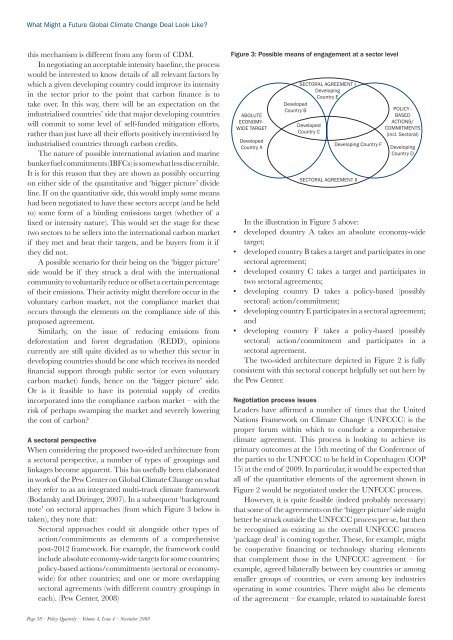Sharing the Burden of Climate Change Policy Quarterly issue with ...
Sharing the Burden of Climate Change Policy Quarterly issue with ...
Sharing the Burden of Climate Change Policy Quarterly issue with ...
Create successful ePaper yourself
Turn your PDF publications into a flip-book with our unique Google optimized e-Paper software.
What Might a Future Global <strong>Climate</strong> <strong>Change</strong> Deal Look Like?<br />
this mechanism is different from any form <strong>of</strong> CDM.<br />
In negotiating an acceptable intensity baseline, <strong>the</strong> process<br />
would be interested to know details <strong>of</strong> all relevant factors by<br />
which a given developing country could improve its intensity<br />
in <strong>the</strong> sector prior to <strong>the</strong> point that carbon finance is to<br />
take over. In this way, <strong>the</strong>re will be an expectation on <strong>the</strong><br />
industrialised countries’ side that major developing countries<br />
will commit to some level <strong>of</strong> self-funded mitigation efforts,<br />
ra<strong>the</strong>r than just have all <strong>the</strong>ir efforts positively incentivised by<br />
industrialised countries through carbon credits.<br />
The nature <strong>of</strong> possible international aviation and marine<br />
bunker fuel commitments (IBFCs) is somewhat less discernible.<br />
It is for this reason that <strong>the</strong>y are shown as possibly occurring<br />
on ei<strong>the</strong>r side <strong>of</strong> <strong>the</strong> quantitative and ‘bigger picture’ divide<br />
line. If on <strong>the</strong> quantitative side, this would imply some means<br />
had been negotiated to have <strong>the</strong>se sectors accept (and be held<br />
to) some form <strong>of</strong> a binding emissions target (whe<strong>the</strong>r <strong>of</strong> a<br />
fixed or intensity nature). This would set <strong>the</strong> stage for <strong>the</strong>se<br />
two sectors to be sellers into <strong>the</strong> international carbon market<br />
if <strong>the</strong>y met and beat <strong>the</strong>ir targets, and be buyers from it if<br />
<strong>the</strong>y did not.<br />
A possible scenario for <strong>the</strong>ir being on <strong>the</strong> ‘bigger picture’<br />
side would be if <strong>the</strong>y struck a deal <strong>with</strong> <strong>the</strong> international<br />
community to voluntarily reduce or <strong>of</strong>fset a certain percentage<br />
<strong>of</strong> <strong>the</strong>ir emissions. Their activity might <strong>the</strong>refore occur in <strong>the</strong><br />
voluntary carbon market, not <strong>the</strong> compliance market that<br />
occurs through <strong>the</strong> elements on <strong>the</strong> compliance side <strong>of</strong> this<br />
proposed agreement.<br />
Similarly, on <strong>the</strong> <strong>issue</strong> <strong>of</strong> reducing emissions from<br />
deforestation and forest degradation (REDD), opinions<br />
currently are still quite divided as to whe<strong>the</strong>r this sector in<br />
developing countries should be one which receives its needed<br />
financial support through public sector (or even voluntary<br />
carbon market) funds, hence on <strong>the</strong> ‘bigger picture’ side.<br />
Or is it feasible to have its potential supply <strong>of</strong> credits<br />
incorporated into <strong>the</strong> compliance carbon market – <strong>with</strong> <strong>the</strong><br />
risk <strong>of</strong> perhaps swamping <strong>the</strong> market and severely lowering<br />
<strong>the</strong> cost <strong>of</strong> carbon?<br />
A sectoral perspective<br />
When considering <strong>the</strong> proposed two-sided architecture from<br />
a sectoral perspective, a number <strong>of</strong> types <strong>of</strong> groupings and<br />
linkages become apparent. This has usefully been elaborated<br />
in work <strong>of</strong> <strong>the</strong> Pew Center on Global <strong>Climate</strong> <strong>Change</strong> on what<br />
<strong>the</strong>y refer to as an integrated multi-track climate framework<br />
(Bodansky and Diringer, 2007). In a subsequent ‘background<br />
note’ on sectoral approaches (from which Figure 3 below is<br />
taken), <strong>the</strong>y note that:<br />
Sectoral approaches could sit alongside o<strong>the</strong>r types <strong>of</strong><br />
action/commitments as elements <strong>of</strong> a comprehensive<br />
post-2012 framework. For example, <strong>the</strong> framework could<br />
include absolute economy-wide targets for some countries;<br />
policy-based actions/commitments (sectoral or economywide)<br />
for o<strong>the</strong>r countries; and one or more overlapping<br />
sectoral agreements (<strong>with</strong> different country groupings in<br />
each). (Pew Center, 2008)<br />
Figure 3: Possible means <strong>of</strong> engagement at a sector level<br />
ABOLUTE<br />
ECONOMY-<br />
WIDE TARGET<br />
Developed<br />
Country A<br />
SECTORAL AGREEMENT I<br />
Developing<br />
Country E<br />
Developed<br />
Country B<br />
Developed<br />
Country C<br />
SECTORAL AGREEMENT II<br />
Developing Country F<br />
POLICY -<br />
BASED<br />
ACTIONS/<br />
COMMITMENTS<br />
(incl. Sectoral)<br />
Developing<br />
Country D<br />
In <strong>the</strong> illustration in Figure 3 above:<br />
• developed dountry A takes an absolute economy-wide<br />
target;<br />
• developed country B takes a target and participates in one<br />
sectoral agreement;<br />
• developed country C takes a target and participates in<br />
two sectoral agreements;<br />
• developing country D takes a policy-based (possibly<br />
sectoral) action/commitment;<br />
• developing country E participates in a sectoral agreement;<br />
and<br />
• developing country F takes a policy-based (possibly<br />
sectoral) action/commitment and participates in a<br />
sectoral agreement.<br />
The two-sided architecture depicted in Figure 2 is fully<br />
consistent <strong>with</strong> this sectoral concept helpfully set out here by<br />
<strong>the</strong> Pew Center.<br />
Negotiation process <strong>issue</strong>s<br />
Leaders have affirmed a number <strong>of</strong> times that <strong>the</strong> United<br />
Nations Framework on <strong>Climate</strong> <strong>Change</strong> (UNFCCC) is <strong>the</strong><br />
proper forum <strong>with</strong>in which to conclude a comprehensive<br />
climate agreement. This process is looking to achieve its<br />
primary outcomes at <strong>the</strong> 15th meeting <strong>of</strong> <strong>the</strong> Conference <strong>of</strong><br />
<strong>the</strong> parties to <strong>the</strong> UNFCCC to be held in Copenhagen (COP<br />
15) at <strong>the</strong> end <strong>of</strong> 2009. In particular, it would be expected that<br />
all <strong>of</strong> <strong>the</strong> quantitative elements <strong>of</strong> <strong>the</strong> agreement shown in<br />
Figure 2 would be negotiated under <strong>the</strong> UNFCCC process.<br />
However, it is quite feasible (indeed probably necessary)<br />
that some <strong>of</strong> <strong>the</strong> agreements on <strong>the</strong> ‘bigger picture’ side might<br />
better be struck outside <strong>the</strong> UNFCCC process per se, but <strong>the</strong>n<br />
be recognised as existing as <strong>the</strong> overall UNFCCC process<br />
‘package deal’ is coming toge<strong>the</strong>r. These, for example, might<br />
be cooperative financing or technology sharing elements<br />
that complement those in <strong>the</strong> UNFCCC agreement – for<br />
example, agreed bilaterally between key countries or among<br />
smaller groups <strong>of</strong> countries, or even among key industries<br />
operating in some countries. There might also be elements<br />
<strong>of</strong> <strong>the</strong> agreement – for example, related to sustainable forest<br />
Page 38 – <strong>Policy</strong> <strong>Quarterly</strong> – Volume 4, Issue 4 – November 2008
















